Feasts and Folklore: Unearthing the History of Traditional Irish Cuisine
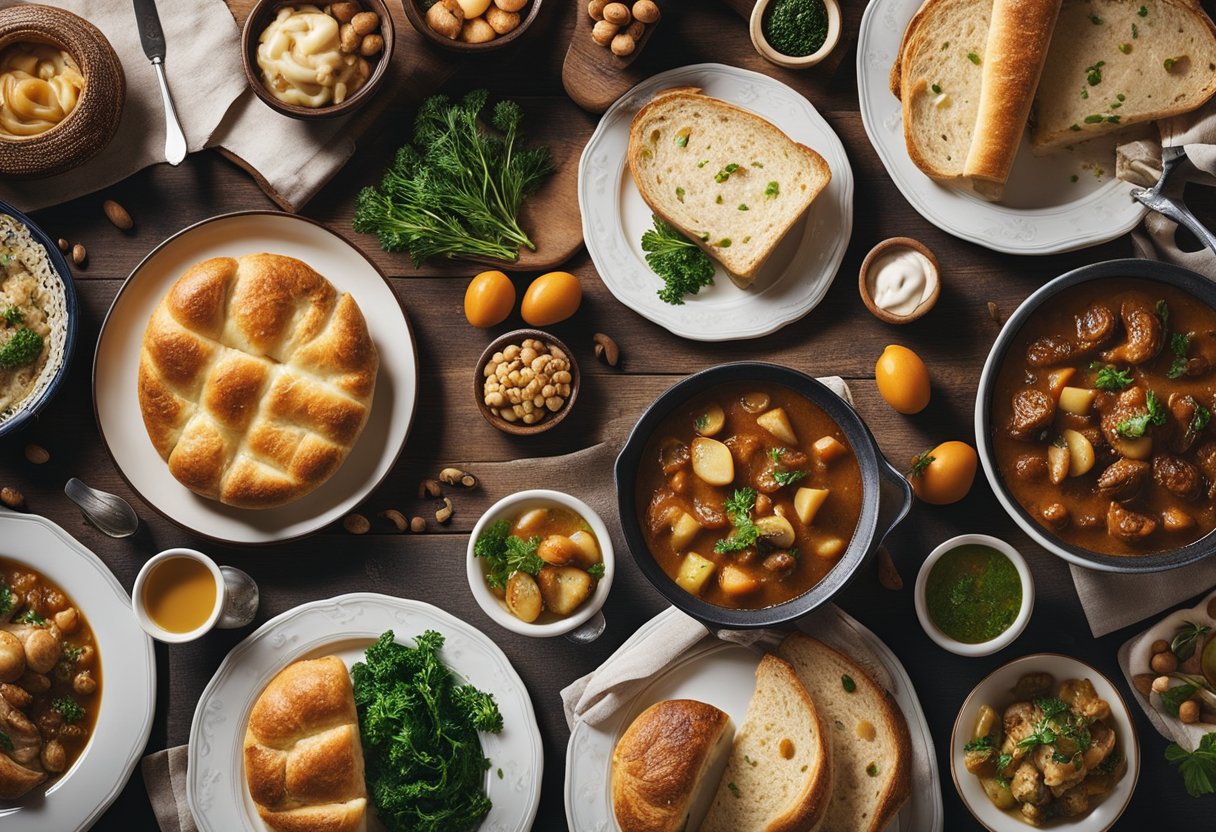
Updated On: April 14, 2024 by Eman Sameh
Within the tapestry of Irish culture, food plays a significant role, intertwining with stories and traditions that date back centuries. Feasts in Ireland are not merely about satisfying hunger; they act as a vehicle for sharing folklore and building community. The traditional dishes we savour are rich in history and carry the essence of Ireland’s heritage, with each ingredient and method steeped in the land’s agricultural past. From the simple, hearty fare of a farmer’s table to the elaborate spreads of feast days, the evolution of Ireland’s culinary tradition mirrors its societal changes and historical influences.
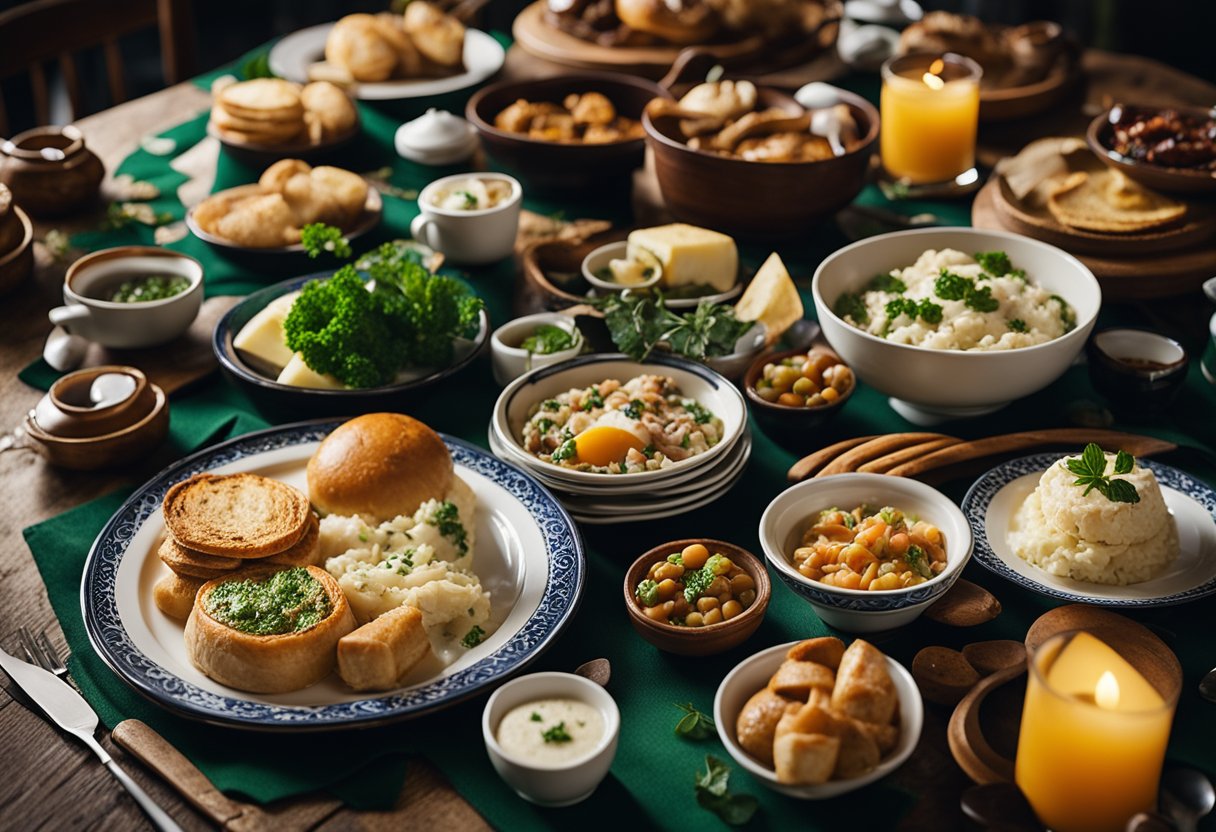
At the heart of this tradition lies a bountiful array of key ingredients: potatoes, meats, and dairy, which form the backbone of Irish cuisine. The significance of these components is magnified by the ceremonial aspects of their preparation and consumption. Alongside these are tales of mythology and gastronomy, where legendary figures are often associated with particular foods and culinary practices. Food serves as a symbol within Irish myth, often playing a central role in tales that have been passed down through generations. Thus, traditional Irish dishes are more than sustenance; they are a means to preserve and evolve a rich culinary heritage, a manifestation of the communal aspects of Irish culture.
Historical Evolution of Irish Cuisine
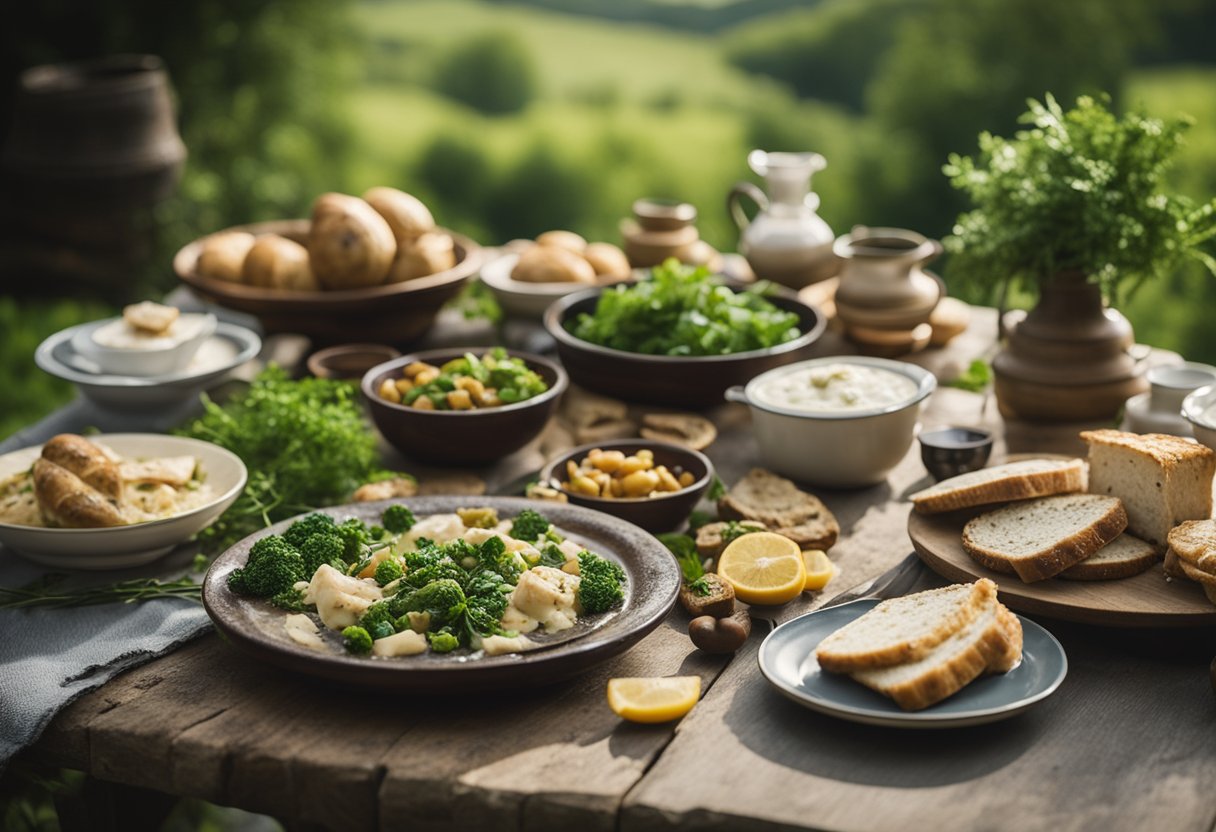
Irish cuisine has undergone a significant transformation from basic sustenance to a rich source of cultural history and storytelling. Our culinary journey reflects both the challenges and the changes that have shaped Ireland.
From Ancient Staples to the Arrival of the Potato
Before the potato became synonymous with our Irish diet, our ancestors were hunter-gatherers who harvested wild plants and relied on cattle for dairy products. The history of Irish food is deeply rooted in these pastoral traditions, with dairy products like milk, cheese, and butter forming the cornerstone of our diet. These staples are combined with the seasonal harvest of fruits and grains to provide nourishment throughout the year.
Potatoes made their defining arrival in the late 16th century. The introduction of this new crop revolutionised Irish agriculture and, subsequently, our cuisine. The potato thrived in our soil and swiftly became a staple food item due to its nutritional value and ease of growth.
Famine and Its Aftermath on Diet
The Great Famine of the mid-19th century had a catastrophic impact on Ireland. Our reliance on potatoes as a primary food source led to disaster when blight devastated crops across the country. The resulting starvation and mass emigration had a profound effect on our diet and the overall framework of Irish society.
In the years that followed, our culinary traditions began to slowly rebuild, incorporating imported foods and broadening the Irish palate. Post-famine, we saw a diversification of the diet in Ireland. Today, Irish cuisine reflects a blend of traditional dishes influenced by the historical events that shaped our nation’s past.
Cultural Significance of Feast Days
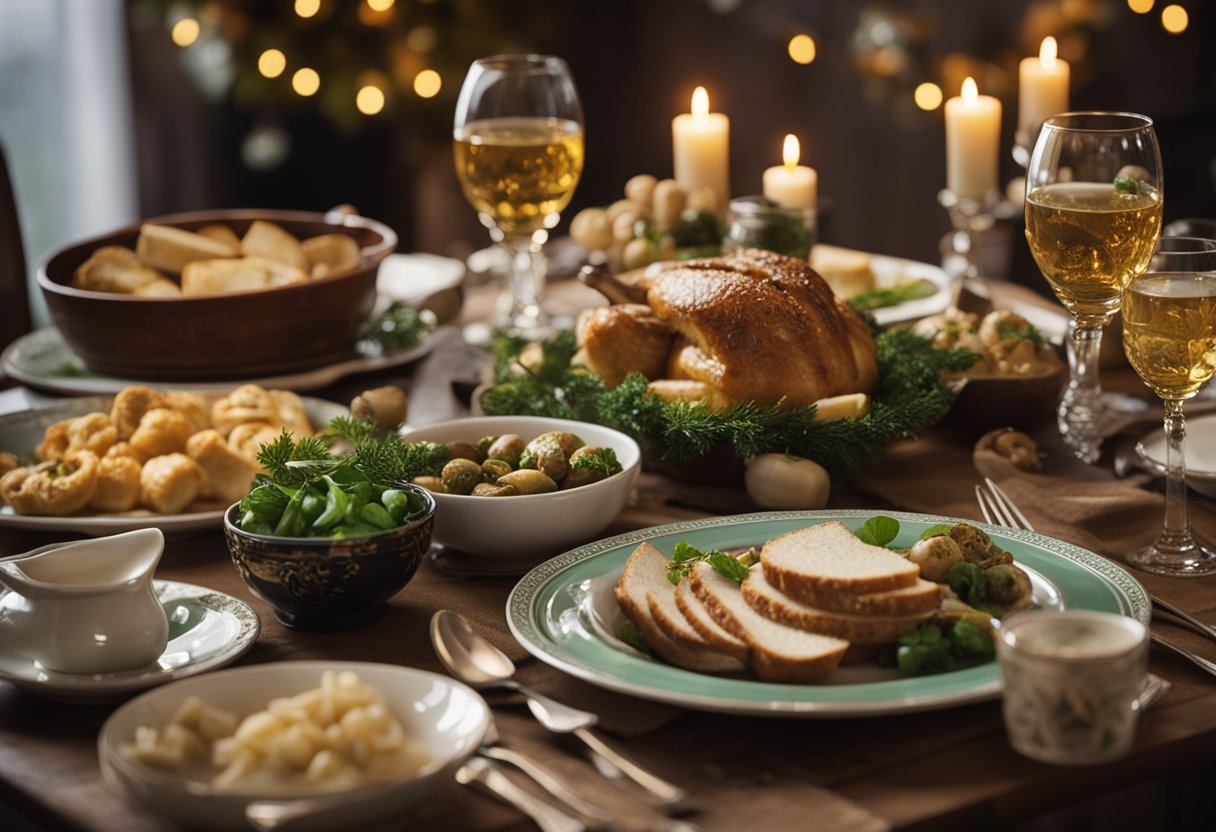
In Ireland, feast days are not just about the food; they are steeped in tradition and folklore that resonate with cultural and historical significance.
Samhain: Rituals and Festivities
Samhain, celebrated on November 1st, marks the end of the harvest season and the beginning of winter. It’s a pivotal day in the Celtic calendar when the boundary between our world and the otherworld was believed to be at its thinnest. Feasts during Samhain included seasonal produce, with an emphasis on sharing the bounty and honouring the dead. Traditional foods, such as colcannon, played a role in divination practices, often containing trinkets that predicted the finder’s future.
Christmas Celebrations and Food Traditions
Christmas in Ireland is a time of communal warmth and cheer. Tradition calls for a lavish dinner comprising a roast, often goose or turkey, and an array of side dishes. The centrepiece is the Christmas pudding, a rich, dense creation that matures weeks in advance. It is laden with symbolism and served as much for its cultural import as for its flavour. Irish homes might also enjoy the Wren Boys Procession, a nod to the Celtic past that blends the superstitions of yore with the festive spirit.
Halloween and Barmbrack: The Lore of Divination
After crossing over from Samhain, Halloween holds a special place in Irish culture, with barmbrack taking centre stage. This yeasted bread, laden with dried fruit, is more than a seasonal treat; it’s a means of divination. Every loaf has a mix of objects baked into it, each foretelling a different fortune for the person who finds it, thus carrying on the ancient practices of Celtic superstitions.
Key Ingredients in Traditional Irish Dishes
Before we explore the specifics, let’s acknowledge that the core of traditional Irish cuisine hinges on the freshness and quality of its ingredients. Rich dairy products and an array of root vegetables form the backbone of many beloved dishes.
The Emphasis on Dairy: Butter and Cheese
We find that dairy, particularly butter and cheese, is prominently featured in Irish culinary traditions. The lush green pastures of Ireland are perfect for raising cows, which in turn produce the rich, creamy milk that is transformed into high-quality dairy products. Irish butter, known for its distinctively golden colour due to the beta-carotene in the grasses, is a staple in both cooking and as a spread. When discussing cheese, one cannot overlook the variety that Ireland offers, from the sharpness of Cheddar to the creaminess of Brie-style cheese, each adding its own depth to both everyday and festive Irish fare.
Root Vegetables and the Irish Larder
Next, we consider the root vegetables, which are a quintessential component of the Irish larder. Potatoes perhaps are the most well-known, not only as a comfort food but also as a symbol of historical significance due to the Great Famine. But let’s not forget about other roots such as carrots, parsnips, and turnips which also play key roles. These vegetables, often seasoned with natural herbs, provide the hearty, earthy flavours that are characteristic of traditional Irish stews and casseroles.
Utilising what is naturally available, Irish cooks have long relied on the rich tapestry of vegetables and herbs to enhance the flavour profiles of their dishes. The respect for natural ingredients is evident in the simplicity yet robustness of traditional recipes, ensuring the essence of each component is honoured.
The Role of Mythology in Irish Gastronomy
We find that mythology weaves through the fabric of Irish gastronomy, bringing depth and character to traditional dishes. The tales of old are not just stories but are embodied in the food itself, each bite a page from Ireland’s storied past.
Myths Embodied in Food
In Ireland, each dish tells a tale, often rooted in the rich soil of myth and legend. Take, for instance, the humble colcannon – this dish transcends its culinary purpose, serving as a traditional storybook of superstitions during Samhain. It was customarily filled with tokens that could predict the diner’s fortune, effectively integrating folklore into the dining experience.
From Salmon of Knowledge to the Legendary Leprechauns
Our gastronomy also draws from narratives of enchanted creatures and divine beings. The Salmon of Knowledge, for instance, is more than a legend; it encapsulates the idea that consuming this fish could bestow immense wisdom, a concept that has tantalised taste buds and minds alike. Similarly, the leprechauns, often associated with luck and riches, have inspired a playful element in Irish cuisine, reminding us that food can be as magical as the pot of gold at a rainbow’s end.
Communal Aspects of Irish Food Culture

In Irish culture, food is a vital link that brings people together and is central to many communal celebrations. Our shared meals and age-old recipes act as a tapestry, weaving a narrative that honours our ancestors and the oral traditions passed down through generations.
Food as a Means of Togetherness
Food in Ireland has always been about more than just sustenance; it symbolises hospitality and togetherness. Gathering around the dinner table, families share not only a meal but also stories, reinforcing bonds and ensuring that the tales of our forebears endure. Meals are often hearty and made to be enjoyed communally, embodying the Irish spirit of warmth and generosity. For instance, a traditional Irish stew becomes an expression of our collective identity, as each ingredient reveals a chapter of our culinary history.
Festive Foods and Community Celebrations
Festive foods play a pivotal role in community celebrations, marking the seasons and the significant feasts of the year. The festivals of Imbolc, Beltaine, Lughnasa, and Samhain feature feasts that encapsulate the essence of Irish conviviality and are a nod to our pagan past. Dishes like colcannon are not just comfort food; they carry within them traditions and stories that are as enriching as the dish itself. During Samhain, for example, hidden charms in colcannon forecast the fortunes of those partaking in the feast—an enchanting blend of cuisine and anticipation.
In these traditions, the community comes together, affirming our shared heritage and reinforcing the understanding that every meal is an opportunity to celebrate our culture’s collective journey.
Farming and the Agricultural Backbone
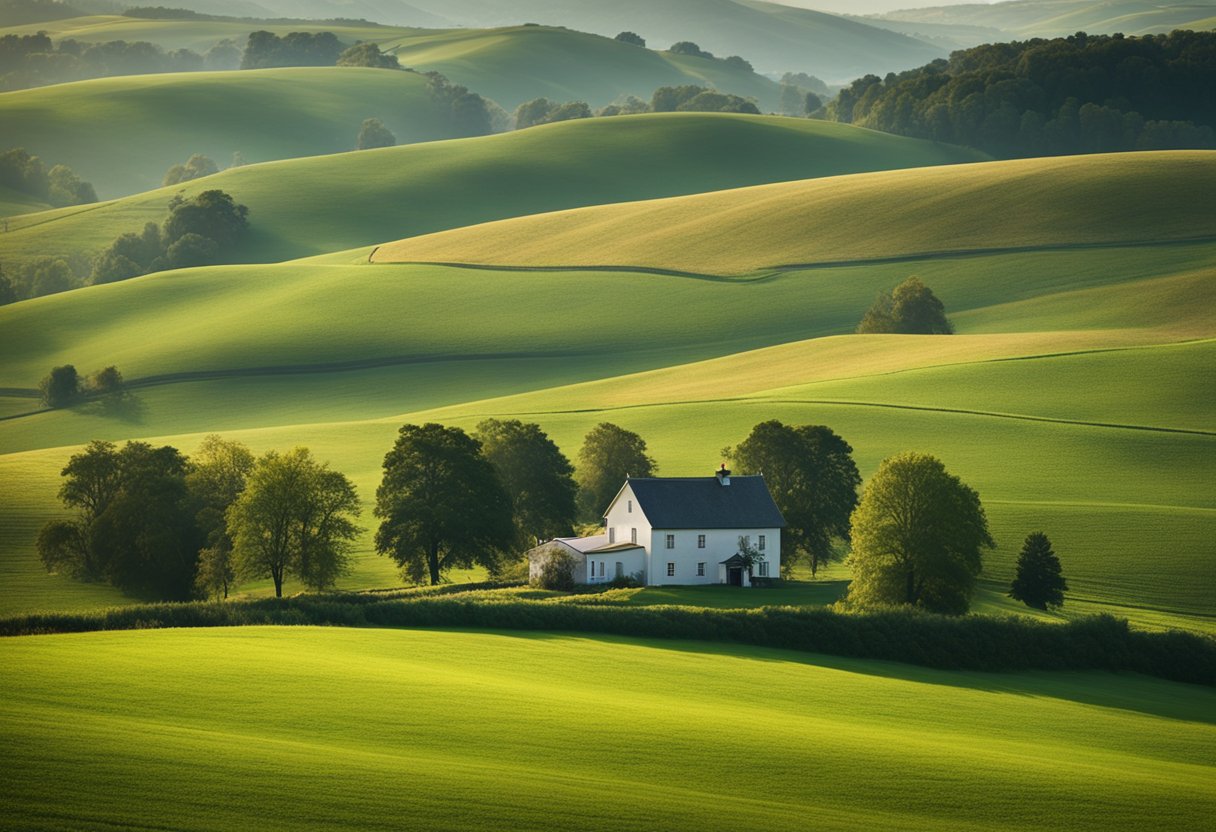
Our culinary traditions are deeply intertwined with the agricultural practices that have shaped Ireland for centuries. From the green pastures feeding our livestock to the seasonal coastal harvests, the bounty of the land and sea has always played a pivotal role in our gastronomic heritage. Let us explore how these elements form the backbone of traditional Irish fare.
Livestock and Pastures in Irish Farm Life
In the patchwork of green that characterises the Irish countryside, cattle grazing on lush pastures are a common sight. Ireland’s reputation for high-quality dairy and beef owes much to our farmers’ commitment to pasture-fed, free-range husbandry. The damp, mild climate yields rich grasslands, creating ideal conditions for livestock to thrive. These traditional methods not only ensure the well-being of the cattle but also give rise to the distinctive taste and quality of Irish dairy products and meats.
Coastal Harvest and Fishing Traditions
Our island status means that coastal communities have historically relied on the sea’s bounty. The harvest of seafood, underpinned by long-standing fishing traditions, has been a cornerstone of our diet. Each year, the coastal cycle of fishing follows a rhythm dictated by the seasons and tides, ensuring that practices are sustainable and that seafood remains a staple on our tables. From mackerel to salmon, the fruits of these labours are key ingredients in age-old recipes passed down through generations.
Traditional Cooking Methods
In exploring the rich tapestry of Irish culinary tradition, two integral methods stand out: cooking over an open fire and adapting ancient techniques to contemporary tastes.
Cooking Over an Open Fire
Historically, Irish cuisine centred on the hearth, where an open fire provided not only warmth but also a communal cooking space. Over these fires, our ancestors tended to pots of broth, slow-cooking ingredients to extract deep flavours. The open fire was the heart of the home, with its constant flame ready to warm a pot of stew or bake soda bread against the hot stones.
Modern Interpretations of Ancient Techniques
Our culinary innovation has not abandoned these historical practices. Instead, we’ve embraced them, infusing age-old methods with new perspectives. For example, chefs now use smoke to enhance the succulent taste of meats, a nod to the open-fire techniques of our past. These modern interpretations honour the simplicity and resourcefulness inherent in our heritage while propelling Irish cuisine into the gastronomic future.
Preserving and Evolving Irish Culinary Heritage
Irish cuisine is deep-rooted in tradition, yet it’s continually being reshaped by innovative chefs and culinary historians. They are essential figures in keeping the Irish culinary heritage alive, ensuring that the stories behind the food are not forgotten.
The Work of Chefs and Culinary Historians
Irish chefs and culinary historians dedicate themselves to preserving our cultural heritage, ensuring that traditional recipes and methods are not lost over time. They meticulously record the oral history surrounding our dishes, such as the lore of Barmbrack during Samhain, connecting us to our past through food. These professionals also educate and inspire others about the importance of our culinary roots, fostering a collective responsibility to maintain this aspect of our culture.
Innovation within Tradition
While cherishing our past, there is also a place for innovation within tradition in Irish cuisine. By imbuing time-honoured recipes with contemporary techniques and global influences, chefs contribute to the evolution of our culinary heritage. This creativity produces dishes that reflect both our history and the changing palate, like the modern variations of stews and the spicebag, a recent take on Irish fast food. It’s through this balance of preservation and innovation that our culinary heritage continuously flourishes, mirroring the dynamism of Ireland itself.
Symbolism and Lore in Irish Festivity Foods
In Irish festivities, food is much more than a means of sustenance; it carries with it centuries of stories, myths, and traditions that are central to Irish culture.
Seasonal Symbols in Irish Festivities
In Ireland, seasonal feasts serve as a conduit for showcasing cultural symbols and engaging in age-old superstitions. Samhain, a festival marking the end of the harvest season, for example, is deeply intertwined with the Gaelic tradition. Dishes consumed during this time, such as barmbrack, are not merely food items but act as storytelling devices. Each charm baked into the barmbrack holds significance: a ring for an impending marriage, a coin for upcoming wealth, or a piece of cloth for misfortune. This traditional Irish bread becomes a map of potential futures, making it a centrepiece of storytelling and myth.
- Barmbrack: Fortune-telling fruit bread served at Samhain.
- Ring: Impending Marriage.
- Coin: Upcoming Wealth.
- Cloth: Misfortune.
Midsummer celebrations often feature bonfires, which were thought to offer protection against evil spirits. The foods consumed during these festivities, like the simple sharing of colcannon, are rooted in the joy of community and connectedness, reflecting the warmth of Irish hospitality.
Food and Drink as Storytelling Devices
Irish feasts abound with legends and lore. Take, for instance, the Christmas plum pudding, laden with tradition and served with a sprig of holly, symbolising Jesus’ crown of thorns. These dishes are steeped in superstitions; it’s believed that making a wish while stirring the pudding mix can bring good fortune for the year ahead.
The act of sharing a pint of Guinness during gatherings is itself a form of communal storytelling, where the day’s toils morph into tales of legend—a nod to Irish culture’s affinity for the spoken word.
- Guinness: More than just a drink, it encircles the tradition of sharing stories.
- Plum Pudding: A Christmas treat enveloped in tradition and myth.
- Holly Sprig: Representation of Jesus’ crown of thorns.
- Wish-Making: Stirring the mix for good fortune.
These festive foods encapsulate a world where every ingredient has a story, and every flavour is a chapter of Ireland’s rich cultural narrative.
Food and Irish Mythological Figures
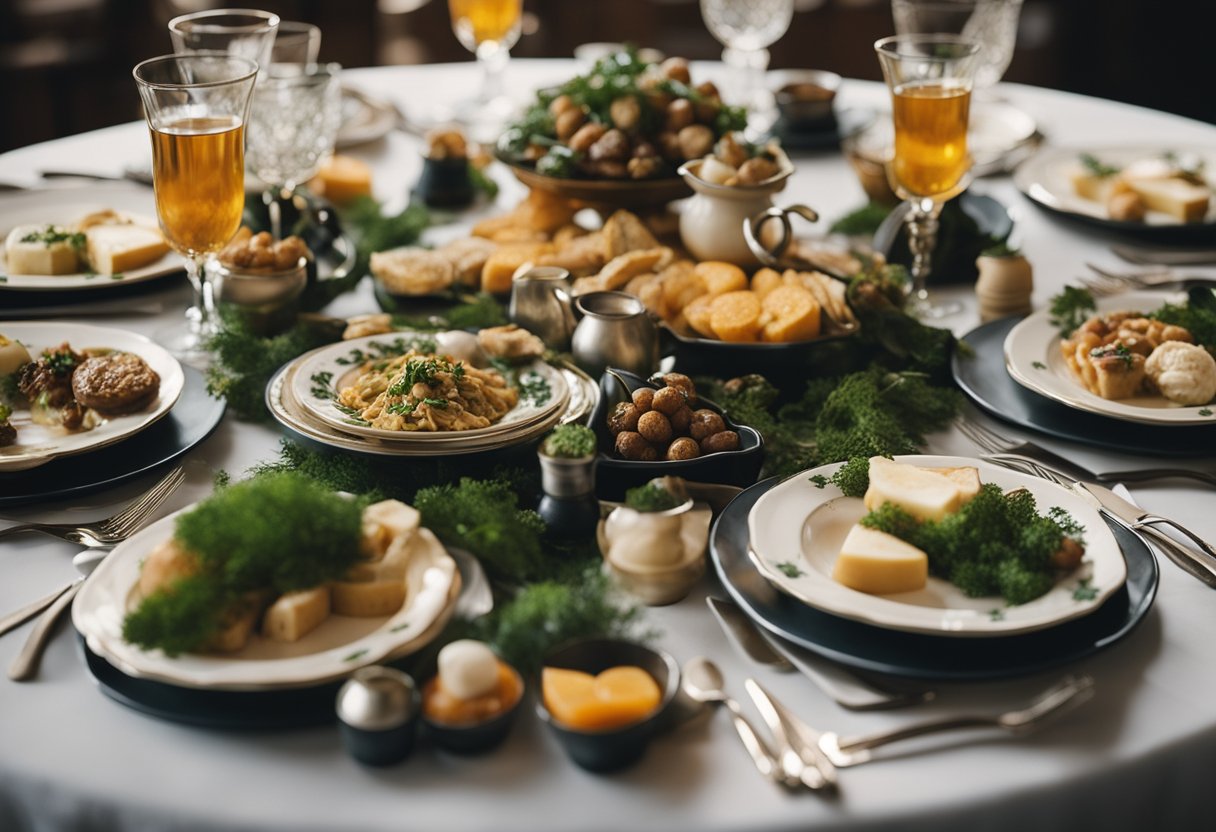
Irish mythology teems with tales of gods and heroes, each with intriguing associations to food that reveal much about the culture and values of ancient Ireland.
Feasts of the Tuatha Dé Danann
The Tuatha Dé Danann, a race of god-like beings in Irish mythology, were known for their grand feasts, which were integral to their society. These occasions displayed their superior skills and abundance, often featuring magical foods that could heal or grant immortality. Legends tell of the Dagda, a prominent figure among the Tuatha Dé Danann, who possessed a cauldron with an endless supply of food and was said to be a source of sustenance for the gods.
Cú Chulainn and Fionn Mac Cumhaill: Heroes’ Diets
Among the pantheon of Irish heroes, Cú Chulainn stands tall. His legendary feats were matched by his dietary preferences, which were said to fortify his superhuman strength. Similarly, Fionn Mac Cumhaill, leader of the warrior band Fianna, is linked with the Salmon of Knowledge, from which he gained all the world’s wisdom. Eating the salmon imbued him with prodigious knowledge and insight, important traits for a hero of his stature.
Frequently Asked Questions
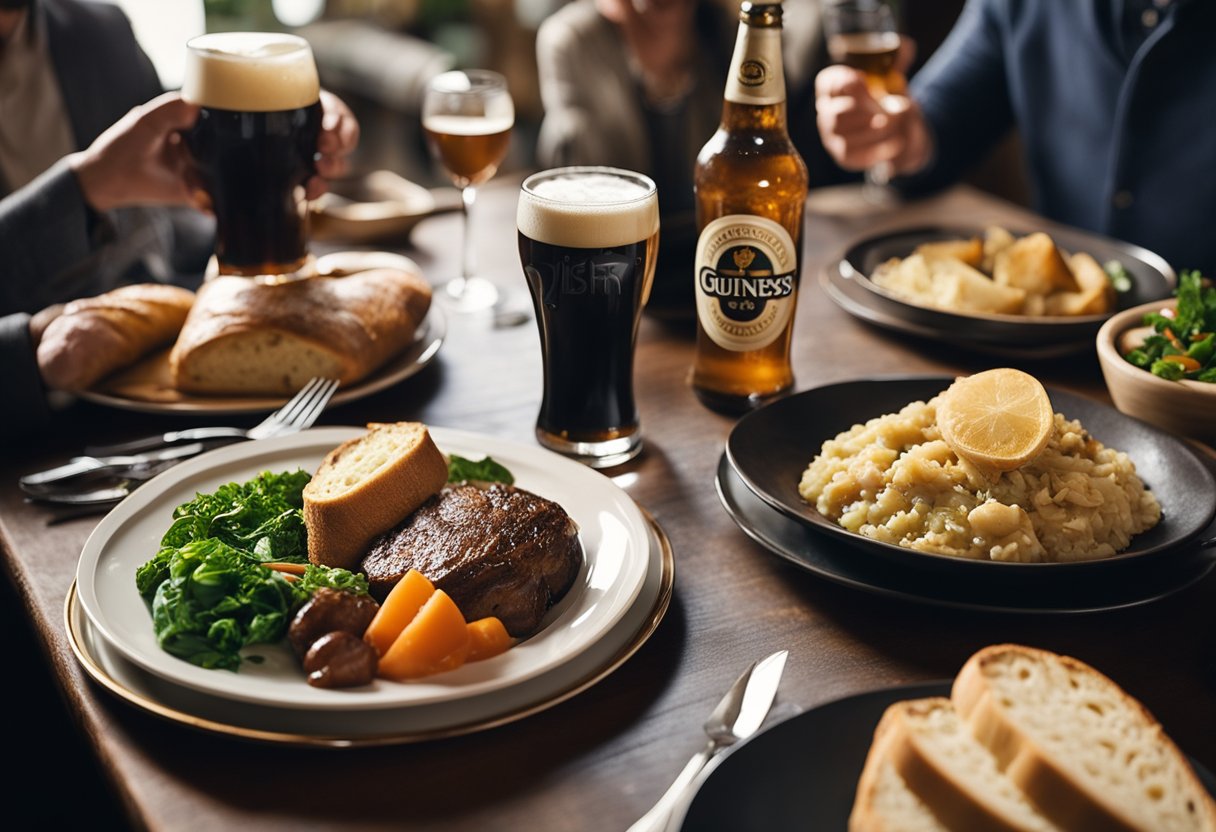
In uncovering the rich tapestry of Ireland’s culinary past, we address the most pressing questions about the origins, evolution, and cultural significance of traditional Irish dishes.
What are the origins and significance of Irish traditional dishes?
Traditional Irish dishes are deeply intertwined with the country’s history and natural resources. For instance, potatoes became a staple due to their ease of cultivation in Ireland’s soil, leading to iconic dishes such as colcannon and Irish stew.
How do Irish folklore and mythology influence local cuisine?
Irish cuisine is woven with tales and beliefs from folklore. Legends of the fairy folk and magical creatures often consisted of specific foods and feasts that today reflect Ireland’s mystical past, adding an enchanting dimension to its traditional dishes.
What historic events have shaped Ireland’s culinary heritage?
Significant events such as the Great Famine profoundly impacted Ireland’s culinary practices. Scarcity led to ingenuity in utilising local ingredients, which forged the heart of Irish cuisine, which was resilient through hardship and rich with hearty, nourishing meals.
Can you outline the evolution of food customs in Ireland from ancient times?
From ancient Celtic feasts to the introduction of dairy farming, Ireland saw a gradual incorporation of meat, vegetables, and grains like barley into its diet. Over centuries, Ireland’s adoption of new foods has reflected its dynamic social and economic shifts.
Which dishes are considered quintessentially Irish and why?
Dishes like soda bread, boxty, and coddle are quintessentially Irish; they embody the simplicity and resourcefulness of traditional Irish cooking, utilising local ingredients plentiful in the Irish landscape.
What role has agriculture played in the development of traditional Irish cuisine?
Agriculture has been a cornerstone of Irish survival and prosperity. The fertile land has yielded crops and livestock that form the backbone of traditional dishes, intrinsically linking Irish cuisine to the rhythms of the agricultural calendar.






